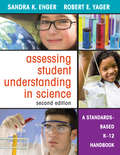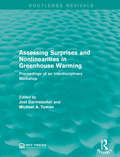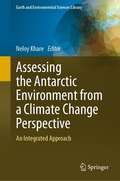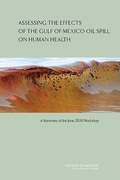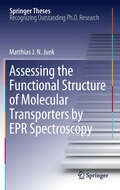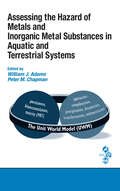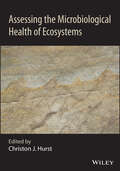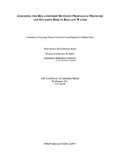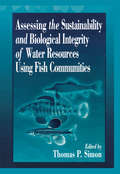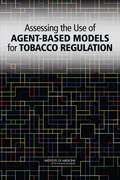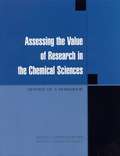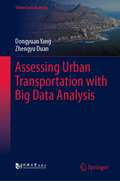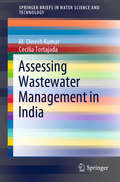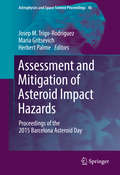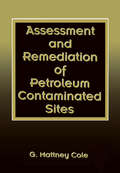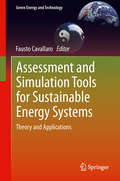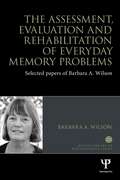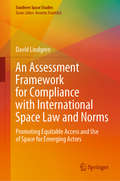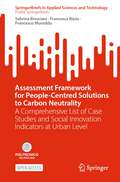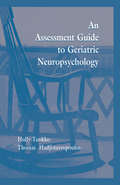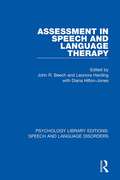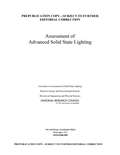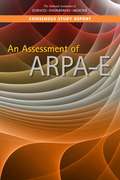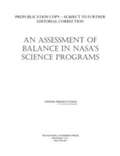- Table View
- List View
Assessing Student Understanding in Science: A Standards-Based K-12 Handbook
by Sandra K. Enger Dr Robert E. YagerProvides extensive standards-based examples for assessing science teaching and learning, including the use of portfolios, formative assessments, student self-evaluations, rubrics, and science notebooks.
Assessing Surprises and Nonlinearities in Greenhouse Warming: Proceedings of an Interdisciplinary Workshop (Routledge Revivals)
by Joel Darmstadter Michael A. TomanIn 1992, Resources for the Future conducted a workshop concerning the issues of global climate change. This title, originally published in 1993, is a collection of the revised versions of the papers commissioned for the workshop with an added introduction and overview. Each paper emphasises the potential nonlinearities or surprises in physical effects caused by humans loading the atmosphere with greenhouse gases and examines how shifts in the natural environment from climate change may affect human well-being. This collection is a valuable resource for any student interested in environmental studies and climate change issues.
Assessing the Antarctic Environment from a Climate Change Perspective: An Integrated Approach (Earth and Environmental Sciences Library)
by Neloy KhareThe present book covers diversified contributions addressing the impact of climate change on the Antarctic environment. It covers the reconstruction of environmental changes using different proxies. The chapters focus on the glacial history, glacial geomorphology, sedimentology, and geochemistry of Antarctic region. Furthermore, the Cenozoic evolution of the Antarctic ice sheet is discussed along with a Scientometrics analysis of climate change research. The book serves as a useful reference for researchers who are fascinated by the polar region and environmental research.
Assessing the Effects of the Gulf of Mexico Oil Spill on Human Health: A Summary of the June 2010 Workshop
by Institute of Medicine of the National AcademiesFrom the origin of the leak, to the amount of oil released into the environment, to the spill's duration, the 2010 Gulf of Mexico oil spill poses unique challenges to human health. The risks associated with extensive, prolonged use of dispersants, with oil fumes, and with particulate matter from controlled burns are also uncertain. There have been concerns about the extent to which hazards, such as physical and chemical exposures and social and economic disruptions, will impact the overall health of people who live and work near the area of the oil spill. Although studies of previous oil spills provide some basis for identifying and mitigating the human health effects of these exposures, the existing data are insufficient to fully understand and predict the overall impact of hazards from the Deepwater Horizon oil spill on the health of workers, volunteers, residents, visitors, and special populations. Assessing the Effects of the Gulf of Mexico Oil Spill on Human Healthidentifies populations at increased risks for adverse health effects and explores effective communication strategies to convey health information to these at-risk populations. The book also discusses the need for appropriate surveillance systems to monitor the spill's potential short- and long-term health effects on affected communities and individuals. Assessing the Effects of the Gulf of Mexico Oil Spill on Human Healthis a useful resource that can help policy makers, public health officials, academics, community advocates, scientists, and members of the public collaborate to create a monitoring and surveillance system that results in "actionable" information and that identifies emerging health risks in specific populations.
Assessing the Functional Structure of Molecular Transporters by EPR Spectroscopy (Springer Theses)
by Matthias J.N.JunkIn his thesis, Matthias Junk takes an innovative approach to assess the local structure and dynamics of biological and synthetic amphiphilic macromolecules capable of transporting small molecules. Replacing the latter with stable radicals, he uses state-of-the-art electron paramagnetic resonance (EPR) spectroscopy to describe the highly relevant transport function from the viewpoint of the guest molecules. Such, he demonstrates that the functional structure of human serum albumin in solution significantly differs from its crystal structure - a consequence of the protein's adaptability to host various endogenous compounds and drug molecules. Further, he shows that the thermal collapse of thermoresponsive hydrogels and dendronized polymers leads to static and dynamic heterogeneities on the nanoscale. These heterogeneities bear consequences for the material's hosting properties and enable unforeseen complex catalytic functionalities.
Assessing the Hazard of Metals and Inorganic Metal Substances in Aquatic and Terrestrial Systems
by William J. Adams Peter M. ChapmanCurrent procedures used for hazard identification and classification are based on persistence, bioaccumulation, and toxicity measurements. Assessing the Hazard of Metals and Inorganic Metal Substances in Aquatic and Terrestrial Systems provides the basis for improvements to the current model for hazard assessment. The book reviews the scientific un
Assessing the Implications of Allowing Transgender Personnel to Serve Openly
by Kayla M. Williams Srikanth Kadiyala Agnes Gereben Schaefer Radha Iyengar Jennifer Kavanagh Amii M. Kress Charles C. EngelThe U.S. Department of Defense is considering a change in policy to allow transgender military personnel to serve openly. A RAND study examined the health care needs of transgender personnel, the costs of gender transition-related care, and the potential readiness implications of a policy change. The experiences of foreign militaries that permit transgender service members to serve openly also point to some best practices for U.S. policymakers.
Assessing the Microbiological Health of Ecosystems
by Christon J. HurstAssessing the Microbiological A timely exploration of the coordinated functions of microbiological communities and the impacts of global climate change on microbial life Ecosystems function like interlocking puzzles and ultimately the health of an ecosystem depends upon the niche activities of its microbial communities. Assessing the Microbiological Health of Ecosystems summarizes our understanding of how microbial community processes are organized and the mechanisms by which activities of their constituent species are coordinated. The authors collectively present a basis for understanding what produces healthy microbial components of an ecosystem, thereby supplying a foundation for achieving one of the eventual future goals of environmental microbiology: to diagnose and correct the integrative nature of microbial activities when ecosystems fail. Assessing the Microbiological Health of Ecosystems will prove to be a valuable resource to environmental microbiologists, ecologists and integrative biologists. The book will: help researchers and students to understand the commonalities of processes, techniques, and discoveries in the study of microbial communities contribute to understandings of how microbial communities coordinate their function, discussing how the relative rates and effective integration of community microbial processes are currently measured provide insights into the composition of a healthy microbial ecosystem By learning to recognize what constitutes and produces a healthy microbial ecosystem, we gain significant ground on the path towards being able to diagnose and correct the health of ailing microbial ecosystems. Assessing the Microbiological Health of Ecosystems will help new generations of scientists discern new ways to carry these efforts forward.
Assessing the Relationship Between Propagule Pressure and Invasion Risk in Ballast Water
by The National Academy of SciencesThe human-mediated introduction of species to regions of the world they could never reach by natural means has had great impacts on the environment, the economy, and society. In the ocean, these invasions have long been mediated by the uptake and subsequent release of ballast water in ocean-going vessels. Increasing world trade and a concomitantly growing global shipping fleet composed of larger and faster vessels, combined with a series of prominent ballast-mediated invasions over the past two decades, have prompted active national and international interest in ballast water management. Assessing the Relationship Between Propagule Pressure and Invasion Risk in Ballast Waterinforms the regulation of ballast water by helping the Environnmental Protection Agency (EPA) and the U. S. Coast Guard (USCG) better understand the relationship between the concentration of living organisms in ballast water discharges and the probability of nonindigenous organisms successfully establishing populations in U. S. waters. The report evaluates the risk-release relationship in the context of differing environmental and ecological conditions,including estuarine and freshwater systems as well as the waters of the three-mile territorial sea. It recommends how various approaches can be used by regulatory agencies to best inform risk management decisions on the allowable concentrations of living organisms in discharged ballast water in order to safeguard against the establishment of new aquatic nonindigenous species, and to protect and preserve existing indigenous populations of fish, shellfish, and wildlife and other beneficial uses of the nation's waters. Assessing the Relationship Between Propagule Pressure and Invasion Risk in Ballast Waterprovides valuable information that can be used by federal agencies, such as the EPA, policy makers, environmental scientists, and researchers.
Assessing the Sustainability and Biological Integrity of Water Resources Using Fish Communities
by Thomas P. SimonThis book examines the application of fish community characteristics to evaluate the sustainability and biological integrity of freshwaters. Topics include perspectives on use of fish communities as environmental indicators in program development, collaboration, and partnership forming; influence of specific taxa on assessment of the IBI; regional applications for areas where the IBI had not previously been developed; and specific applications of the IBI developed for coldwater streams, inland lakes, Great Lakes, reservoirs, and tailwaters.
Assessing the Use of Agent-Based Models for Tobacco Regulation
by Robert WallaceTobacco consumption continues to be the leading cause of preventable disease and death in the United States. The Food and Drug Administration (FDA) regulates the manufacture, distribution, and marketing of tobacco products - specifically cigarettes, cigarette tobacco, roll-your-own tobacco, and smokeless tobacco - to protect public health and reduce tobacco use in the United States. Given the strong social component inherent to tobacco use onset, cessation, and relapse, and given the heterogeneity of those social interactions, agent-based models have the potential to be an essential tool in assessing the effects of policies to control tobacco. Assessing the Use of Agent-Based Models for Tobacco Regulation describes the complex tobacco environment; discusses the usefulness of agent-based models to inform tobacco policy and regulation; presents an evaluation framework for policy-relevant agent-based models; examines the role and type of data needed to develop agent-based models for tobacco regulation; provides an assessment of the agent-based model developed for FDA; and offers strategies for using agent-based models to inform decision making in the future.
Assessing the Value of Research in the Chemical Sciences: Report of a Workshop
by Chemical Sciences RoundtableThis book captures the messages from a workshop that brought together research managers from government, industry, and academia to review and discuss the mechanisms that have been proposed or used to assess the value of chemical research.The workshop focused on the assessment procedures that have been or will be established within the various organizations that carry out or fund research activities, with particular attention to the Government Performance and Results Act (GPRA). The book presents approaches and ideas from leaders in each area that were intended to identify new and useful ways of assessing the value and potential impact of research activities.
Assessing Urban Transportation with Big Data Analysis (Urban Sustainability)
by Dongyuan Yang Zhengyu DuanThis book chiefly focuses on urban traffic, an area supported by massive amounts of data. The application of big data to urban traffic provides strategic and technical methods for the multi-directional and in-depth observation of complex adaptive systems, thus transforming conventional urban traffic planning and management methods. Sharing valuable insights into how big data can be applied to urban traffic, it offers a valuable asset for information technicians, traffic engineers and traffic data analysts alike.
Assessing Wastewater Management in India (SpringerBriefs in Water Science and Technology)
by M. Dinesh Kumar Cecilia TortajadaThis book highlights the institutional, legal, and policy measures to manage water pollution in India, and discusses how effective they have been in improving the overall quality of the country’s surface and groundwater resources. It also reviews the status of wastewater generation, collection and treatment in urban areas to provide insights into the gaps in wastewater treatment. Further, it offers a detailed analysis of the wastewater treatment systems available and examines the human health impacts of water pollution in the country, as well as the future trajectory of investment in wastewater treatment systems and potential sectors for reuse and recycling of wastewater, briefly assessing the market demand for treated wastewater. Lastly, it investigates the factors influencing the environmental sustainability and economic viability of wastewater treatment as well as future areas of research in the field.
Assessment and Mitigation of Asteroid Impact Hazards: Proceedings of the 2015 Barcelona Asteroid Day (Astrophysics and Space Science Proceedings #46)
by Josep M. Trigo-Rodríguez Maria Gritsevich Herbert PalmeCollecting the research presented at the Asteroid Day INTERNATIONAL WORKSHOP celebrated at Barcelona on June 30th, 2015,this proceedings discusses the new era that has just started in the study and exploration of solar system minor bodies. International Asteroid Day commemorates the Tunguska event of June 30th, 1908 in order to promote the importance of dealing proactively with impact hazards from space. Multidisciplinary experts contribute to this discussion in describing the nature of comets and asteroids along with their offspring, meteorites. New missions and space projects aimed at sampling Near Earth Asteroids to bring these materials back to Earth such as Osiris-REx and Hayabusa 2 are described,as well as the AIM and DART projects to test impact deflection techniques for Potentially Hazardous Asteroids encounters. The proceedings includes both an outreach level to popularize impact hazard, and a scientific character, compiling the most modern knowledge on these topics AND PROPOSING NEW TECHNIQUES TO GAIN INSIGHT ON THE PROPERTIES OF THESE CHALLENGING BODIES BY STUDYING METEOROIDS AND METEORITES. Asteroids, comets and meteorites are introduced with descriptions of their nature, origin, and solar system pathways.
Assessment and Remediation of Petroleum Contaminated Sites
by G. Mattney ColeFederal regulations have required thousands of underground storage tanks (USTs) to be dug up and removed or replaced. The contamination of soil and ground water from leaking USTs has become widespread and has produced an overwhelming number of sites that require remediation. Assessment and Remediation of Petroleum Contaminated Sites presents the broad scope of the remedial process from initial site assessment to closure in an integrated, understandable format. The book guides you effortlessly through regulatory requirements, site assessments and sampling, and remediation methods. RCRA and CERCLA federal regulations are addressed. The chemistry and toxicology of petroleum hydrocarbons in the remediation process are explained, and factors affecting soil remediation are discussed. Environmental assessments, site characterizations, remediation planning, and remediation methods are all covered in detail. The book is an essential guide for environmental consultants, regulatory agency personnel, engineers, and environmental attorneys.
Assessment and Simulation Tools for Sustainable Energy Systems: Theory and Applications (Green Energy and Technology #129)
by Fausto CavallaroIn recent years, the concept of energy has been revised and a new model based on the principle of sustainability has become more and more pervasive. The appraisal of energy technologies and projects is complex and uncertain as the related decision making has to encompass environmental, technical, economic and social factors and information sources. The scientific procedure of assessment has a vital role as it can supply the right tools to evaluate the actual situation and make realistic forecasts of the effects and outcomes of any actions undertaken. Assessment and Simulation Tools for Sustainable Energy Systems offers reviews of the main assessment and simulation methods used for effective energy assessment. Divided across three sections, Assessment and Simulation Tools for Sustainable Energy Systems develops the reader's ability to select suitable tools to support decision making and implementation of sustainable energy projects. The first is dedicated to the analysis of theoretical foundations and applications of multi-criteria decision making. This is followed by chapters concentrating on the theory and practice of fuzzy inference, neural nets and algorithms genetics. Finally, simulation methods such as Monte Carlo analysis, mathematical programming and others are detailed. This comprehensive illustration of these tools and their application makes Assessment and Simulation Tools for Sustainable Energy Systems a key guide for researchers, scientists, managers, politicians and industry professionals developing the field of sustainable energy systems. It may also prompt further advancements in soft computing and simulation issues for students and researchers.
The Assessment, Evaluation and Rehabilitation of Everyday Memory Problems: Selected papers of Barbara A. Wilson (World Library of Psychologists)
by Barbara A. WilsonIn the World Library of Psychologists series, international experts present career-long collections of what they judge to be their finest work—extracts from books, key articles, salient research findings and their major theoretical and practical contributions. This volume of self-selected papers recognises Professor Barbara A. Wilson's major contribution to the study of neuropsychology. Published over a 25-year period, the papers included here address the assessment, treatment and evaluation of rehabilitation provided to people who have memory difficulties arising from an injury or illness affecting the brain. This selection of papers includes work on errorless learning, the natural history of the development of compensatory memory systems, paging systems developed to enhance independent daily living for memory impaired people and single-case experimental designs to appraise the response of individual patients. The final section includes a practical framework for understanding compensatory behaviour, a model of cognitive rehabilitation and a discussion of the dilemmas created by the different aims of neuroscience as opposed to those of clinicians. This book will be of great interest to clinical psychologists, neuropsychologists, occupational therapists and speech and language therapists, along with anyone who is interested in reducing the impact of memory problems on people who have suffered brain injury.
An Assessment Framework for Compliance with International Space Law and Norms: Promoting Equitable Access and Use of Space for Emerging Actors (Southern Space Studies)
by David LindgrenThis book proposes a framework for assessing countries’ levels of compliance with international space law and norms. It begins by exploring the development of two movements – the evidence-based policymaking and programming movement, and the rise of ratings and rankings research – and their growth across various disciplines. The analysis suggests that such efforts are useful in gauging the behavior of countries in space according to how well they adhere to existing space law and norms. To date, there is no comprehensive, periodic, and systematic measure of countries’ efforts to comply with space law and norms; this work endeavors to fill that gap by offering a framework in which to assess compliance. Applying the framework results in five possible ratings that a country may be assigned, ranging from highly compliant to non-compliant. Ideally, the proposed framework can be used to promote compliance, and with it, space security and sustainability.
Assessment Framework for People-Centred Solutions to Carbon Neutrality: A Comprehensive List of Case Studies and Social Innovation Indicators at Urban Level (SpringerBriefs in Applied Sciences and Technology)
by Sabrina Bresciani Francesca Rizzo Francesco MuredduThis open access book presents a catalogue of over one thousand indicators which can be used by cities' public administrators to monitor and evaluate social innovation action plans to support people-centred, collaborative or co-designed solutions to lower carbon emissions. Indicators are clustered according to a framework of social innovation solutions for climate neutrality at city level, developed by merging top-down academic knowledge with bottom-up pragmatic case studies. There is currently limited guidance on how to embed social innovations in their cities’ action plans with the aim of reaching climate neutrality, and on how to assess the progress and impacts of such people-centred projects in cities. The book addresses this gap and is thus relevant for scholars in the field of policy-making and design, as well as cities’ transition teams, policymakers and consultants. Based on the work developed within the EU-funded project NetZeroCities, intervention logics are provided for each of the ten categories of action, with related indicators clustered by category and evaluation criteria (effectiveness, efficiency, relevance, replicability, and scalability). Guidelines to implement the framework support city administrators in defining steps they need to follow to apply the indicators to their local case, making social innovation a crucial lever for accelerating systemic transformation.
An Assessment Guide To Geriatric Neuropsychology
by Holly Tuokko Thomas HadjistavropoulosAt least half of all neuropsychological assessments are performed on elderly persons, but the information clinicians need to make appropriate judgment calls is widely scattered. Several books offering general descriptions of the cognitive functioning of the aged or of neuropsychological conditions affecting them are helpful to practitioners but do not provide reliable and valid normative information. Two books that do provide this information do not focus on geriatric populations. A concise, yet comprehensive summary of what we now know about those over 65--with an extensive bibliography--An Assessment Guide to Geriatric Neuropsychology fills the gap. The neuropsychological assessment of elderly persons involves not only the performance-based measurement of various capacities but heavy reliance on reports from caregivers (both formal and informal) about the day to day functioning of the affected person. It also raises important, yet often neglected, ethical concerns. The authors discuss all the measures that detect and discriminate among cognitive disorders of elderly persons, including special measures relevant to caregiver reports, and provide useful tables to assist in differential diagnosis. They also reflect on the ethical issues that often confront the assessor of an elderly individual: informed consent, confidentiality, the right of bodily autonomy and self-determination, and appropriate feedback. This book will be an invaluable resource for all those called on to evaluate older clients.
Assessment in Speech and Language Therapy (Psychology Library Editions: Speech and Language Disorders)
by John R. Beech Leonora Harding Diana Hilton-JonesWhat assessment tests are available to speech therapists? How are they best used? Originally published in 1993, Assessment in Speech and Language Therapy was designed to guide speech therapists in choosing the most appropriate assessments for evaluation, monitoring and intervention at the time. By providing guidance on defining the issues in assessment, it shows how to make sure that the process will produce a result relevant to the therapist’s own needs and those of his or her clients. The major issues involved are discussed in detail, in particular how to make sure that assessments are relevant to individual needs. This title will be invaluable to all speech therapists and clinical psychologists working in this area.
Assessment of Advanced Solid-State Lighting
by Committee on Assessment of Solid-State Lighting Board On Energy Environmental SystemsThe standard incandescent light bulb, which still works mainly as Thomas Edison invented it, converts more than 90% of the consumed electricity into heat. Given the availability of newer lighting technologies that convert a greater percentage of electricity into useful light, there is potential to decrease the amount of energy used for lighting in both commercial and residential applications. Although technologies such as compact fluorescent lamps (CFLs) have emerged in the past few decades and will help achieve the goal of increased energy efficiency, solid-state lighting (SSL) stands to play a large role in dramatically decreasing U.S. energy consumption for lighting. This report summarizes the current status of SSL technologies and products-light-emitting diodes (LEDs) and organic LEDs (OLEDs)-and evaluates barriers to their improved cost and performance. Assessment of Advanced Solid State Lighting also discusses factors involved in achieving widespread deployment and consumer acceptance of SSL products. These factors include the perceived quality of light emitted by SSL devices, ease of use and the useful lifetime of these devices, issues of initial high cost, and possible benefits of reduced energy consumption.
An Assessment of ARPA-E
by National Academies of Sciences Engineering MedicineIn 2005, the National Research Council report Rising Above the Gathering Storm recommended a new way for the federal government to spur technological breakthroughs in the energy sector. It recommended the creation of a new agency, the Advanced Research Projects Agency-Energy, or ARPA-E, as an adaptation of the Defense Advanced Research Projects Agency (DARPA) model—widely considered a successful experiment that has funded out-of-the-box, transformative research and engineering that made possible the Internet, GPS, and stealth aircraft. This new agency was envisioned as a means of tackling the nation’s energy challenges in a way that could translate basic research into technological breakthroughs while also addressing economic, environmental, and security issues. Congress authorized ARPA-E in the 2007 America COMPETES Act and requested an early assessment following 6 years of operation to examine the agency’s progress toward achieving its statutory mission and goals. This report documents the results of that assessment. It includes both an operational assessment of the agency’s funding programs and a technical assessment of its awards, to the extent possible.
An Assessment Of Balance In Nasa's Science Programs
by National Research Council of the National AcademiesWhen the space exploration initiative was announced, Congress asked the NRC to review the science NASA proposed to carryout under the initiative. It also asked the NRC to assess whether this program would provide balanced scientific research across the established disciplines supported by NASA in addition to supporting the new initiative. In 2005, the NRC released three studies focusing on a portion of that task, but changes at NASA forced the postponement of the last phase. This report presents that last phase with an assessment of the health of the NASA scientific disciplines under the budget requests imposed by the exploration initiative. The report also provides an analysis of whether the science budget appropriately reflects cross-disciplinary scientific priorities.
